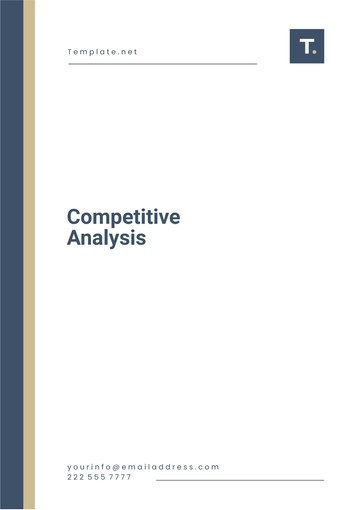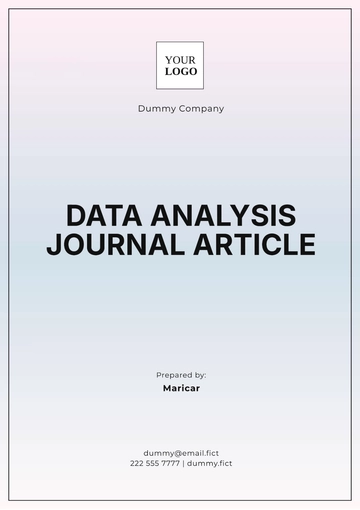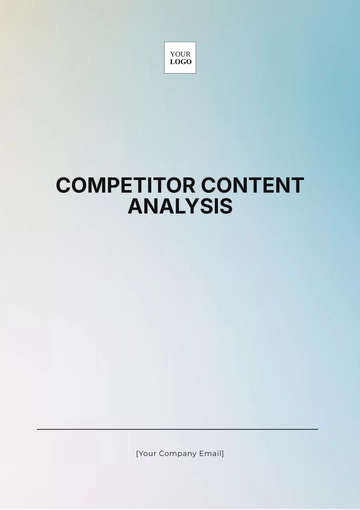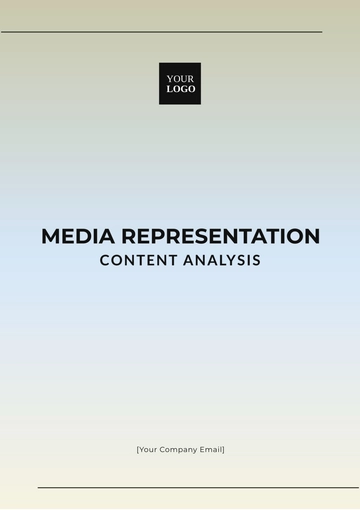Free Strategic Business Literary Analysis

Prepared by: [Your Name]
Date: [Date]
1. Introduction
Strategic business analysis is a critical process that helps organizations navigate the complexities of today's business environment. This analysis reviews and synthesizes academic and practical literature on business strategies to identify effective approaches for achieving competitive advantage and sustaining long-term success. The purpose is to explore various theories, models, and frameworks that can be applied to real-world business challenges and strategic planning.
2. Literature Review
2.1 Overview of Strategic Management Theories
Strategic management theories provide foundational insights into how businesses can formulate and execute strategies effectively. These theories offer various perspectives on achieving and maintaining competitive advantage.
A. Classical Strategic Management Theories
Porter’s Five Forces: This model evaluates the competitive dynamics within an industry. It includes:
Threat of New Entrants: The potential for new competitors to enter the market.
Bargaining Power of Suppliers: The influence suppliers have over prices and terms.
Bargaining Power of Buyers: The impact customers have on pricing and quality.
Threat of Substitutes: The likelihood of customers finding alternative solutions.
Industry Rivalry: The intensity of competition among existing firms.
SWOT Analysis: This framework helps in assessing:
Strengths: Internal capabilities that provide an advantage.
Weaknesses: Internal limitations that may hinder performance.
Opportunities: External factors that could be leveraged for growth.
Threats: External challenges that could impact success.
BCG Matrix: A portfolio management tool that categorizes products into:
Stars: High growth, high market share.
Question Marks: High growth, low market share.
Cash Cows: Low growth, high market share.
Dogs: Low growth, low market share.
B. Modern Strategic Management Theories
Blue Ocean Strategy: Focuses on creating new market spaces (blue oceans) rather than competing in saturated markets (red oceans). Key principles include:
Value Innovation: Offering unique value to customers.
Differentiation: Standing out from competitors.
Resource-Based View (RBV): Emphasizes leveraging valuable, rare, inimitable, and non-substitutable resources to gain a competitive edge. Key resources might include:
Intellectual Property: Patents, trademarks.
Brand Equity: Market reputation and customer loyalty.
Dynamic Capabilities Theory: Examines how firms adapt and reconfigure resources to respond to changing environments. Essential capabilities include:
Innovation: Ability to develop new products and services.
Flexibility: Capacity to adjust strategies based on market conditions.
2.2 Key Strategic Frameworks and Models
Strategic frameworks and models provide structured approaches to strategy development and execution.
A. Balanced Scorecard
The Balanced Scorecard translates strategic objectives into performance measures across four perspectives:
Financial: Metrics such as ROI, and revenue growth.
Customer: Indicators like customer satisfaction, and retention rates.
Internal Business Processes: Efficiency measures, quality control.
Learning and Growth: Metrics on employee training, innovation.
B. Value Chain Analysis
Value Chain Analysis breaks down an organization's activities to identify sources of competitive advantage. Activities are categorized into:
Primary Activities: Inbound logistics, operations, outbound logistics, marketing and sales, and service.
Support Activities: Procurement, technology development, human resource management, firm infrastructure.
2.3 Trends in Strategic Business Research
Recent literature highlights several trends affecting strategic management.
Sustainability in Strategy: Emphasizing environmental and social considerations into business strategies. Examples include:
Green Technologies: Adoption of eco-friendly practices.
Social Responsibility: Corporate initiatives supporting community welfare.
Digital Transformation: The use of digital technologies to drive innovation and efficiency. Examples include:
Artificial Intelligence: Enhancing decision-making and automation.
Blockchain: Improving transparency and security in transactions.
Globalization: Strategies for managing international operations and competition. Key considerations include:
Cross-Cultural Management: Navigating diverse cultural environments.
Global Supply Chains: Managing logistics and sourcing on a global scale.
3. Methodology
3.1 Literature Selection
The literature for this analysis was selected based on its relevance, recency, and impact. Sources included peer-reviewed academic journals, industry reports, and influential business textbooks. Key criteria for selection were the robustness of findings and their applicability to contemporary strategic issues.
3.2 Analytical Approach
A systematic review approach was employed:
Literature Search: Identifying relevant sources.
Critical Appraisal: Evaluating the quality and relevance of each source.
Synthesis: Integrating findings from multiple sources to form comprehensive insights.
Application: Relating theoretical models to practical business contexts.
4. Analysis
4.1 Application of Strategic Theories
A. Porter’s Five Forces in Modern Industries
Tech Industry:
Rivalry: High due to rapid innovation and numerous competitors.
Threat of New Entrants: Moderate, influenced by technological barriers and capital requirements.
Pharmaceutical Industry:
Supplier Power: High due to specialized inputs and regulatory controls.
Threat of Substitutes: Low, due to the unique nature of pharmaceutical products and patents.
B. SWOT Analysis in Strategic Planning
Retail Company:
Strengths: Strong brand presence and customer loyalty.
Weaknesses: Supply chain inefficiencies.
Opportunities: Growth in online shopping.
Threats: Increasing competition from e-commerce giants.
C. Resource-Based View (RBV) in Competitive Advantage
Apple Inc.:
Unique Resources: Proprietary technology, strong brand reputation.
Competitive Advantage: Sustained through innovation and premium product offerings.
4.2 Emerging Strategic Themes
A. Sustainability and CSR
Companies like Unilever have successfully integrated sustainability into their core strategies, achieving both environmental benefits and enhanced financial performance. Key initiatives include reducing carbon footprints and promoting ethical sourcing.
B. Digital Transformation
Amazon exemplifies digital transformation through its use of advanced technologies to disrupt traditional retail. Key strategies include leveraging data analytics for customer insights and utilizing automation in logistics.
5. Discussion
5.1 Strategic Implications for Businesses
The analysis highlights the importance of flexibility and continuous adaptation in strategic planning. Businesses should adopt a dynamic approach, integrating emerging trends and technologies into their strategies to maintain a competitive edge.
5.2 Practical Applications of Strategic Frameworks
Frameworks such as the Balanced Scorecard and Value Chain Analysis offer valuable tools for aligning business activities with strategic objectives and identifying areas for improvement. These frameworks help organizations to focus on key performance metrics and optimize their operations.
5.3 Future Research Directions
Future research should explore the integration of cutting-edge technologies like AI and blockchain into strategic management. Additionally, the impact of global challenges, such as climate change and economic volatility on business strategies, should be investigated further.
6. Conclusion
This Strategic Business Literary Analysis provides a comprehensive overview of essential theories, models, and trends in strategic management. By synthesizing current literature, the analysis offers actionable insights for businesses seeking to enhance their strategic planning and execution.
7. References
Porter, M. (2051). Competitive Strategy: Techniques for Analyzing Industries and Competitors. Journal of Strategic Management. This source introduces the Five Forces framework for analyzing industry structure, focusing on competitive dynamics and market forces.
Kaplan, R. S., & Norton, D. P. (2057). The Balanced Scorecard: Translating Strategy into Action. Harvard Business Review. This book discusses the Balanced Scorecard as a strategic management tool, offering insights on how to translate business strategies into performance measures.
Barney, J. (2055). Firm Resources and Sustained Competitive Advantage. Strategic Management Journal. This paper explores the Resource-Based View (RBV) of strategic management, emphasizing the importance of valuable, rare, inimitable, and non-substitutable resources in achieving competitive advantage.
- 100% Customizable, free editor
- Access 1 Million+ Templates, photo’s & graphics
- Download or share as a template
- Click and replace photos, graphics, text, backgrounds
- Resize, crop, AI write & more
- Access advanced editor
Unlock insightful business analysis with the Strategic Business Literary Analysis Template from Template.net. This customizable, editable tool is designed for professionals who need precision. Tailor your analysis effortlessly, as it's fully editable in our Ai Editor Tool. Perfect for detailed, strategic insights, this template streamlines your workflow while enhancing accuracy and clarity.





























